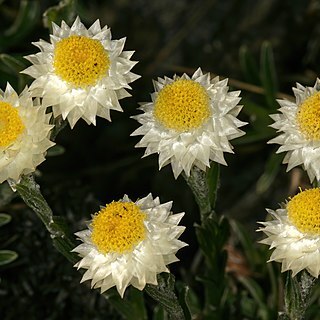Perennial herb or subshrub; flowering stems up to 150 mm high; procumbent, mat-forming, leafy. Leaves sessile; blade linear or very narrowly obovate, 10-100 x 1.5-3.0(-5.0) mm, upper surface glandular-pubescent, sometimes white-felted, lower surface usually glabrous with wool confined to margins, margins slightly involute; 3-veined. Heads discoid, campanulate, 7-12(-15) x 12-25 mm, solitary or up to 4 clustered at tips of stems. Involucral bracts in ± 6 series, graded, loosely imbricate, ± equalling florets, glossy white, occasionally washed palest yellowish brown outside, radiating, stereome divided. Receptacle epaleate, shortly honeycombed. Flowers: disc florets only, 71-154; corolla narrowly campanulate above, yellow; Sep.-Mar. Fruit with cypsela (and ovary) hairy. Pappus of many barbellate bristles, bases cohering strongly by patent cilia.
Stems many, well-branched, prostrate, older parts rooting, young parts leafy. Leaves initially ± rosetted, 10-100 mm long, linear or linear-lanceolate, upper surface usually glandular-pubescent, lower surface usually with wool confined to margins and 3 parallel veins. Capitula campanulate, 7-15 mm long, 1-4 clustered at tips of erect, leafy stems up to 150 mm high; involucral bracts in ± 6 series, graded, glossy white or very pale yellow-brown outside. Flowers 71-154, yellow. Flowering time July-Dec. Pappus of many bristles. Cypselae ± 1.25 mm long, barrel-shaped.
Prostrate, mat-forming perennial herb or subshrub. Leaves 10-100 x l,5-3.0(-5.0) mm, linear or linear-lanceolate. Heads campanulate, 7-12(-15) mm long, solitary or up to 4 clustered at tips of stems. Flowers yellow; involucral bracts glossy white, occasionally washed palest yellowish brown outside.

